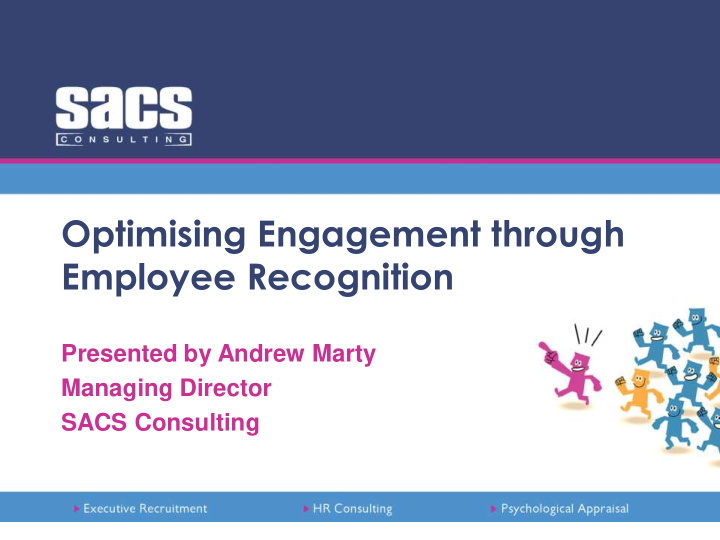



Optimising Engagement through Employee Recognition Presented by Andrew Marty Managing Director SACS Consulting
Objectives • Engagement and why it is worth worrying about • What causes engagement? • The link between employee recognition and engagement • “Sources” of recognition • Optimum recognition and how to achieve it • Automated methods – eg Brownie Points. 2
Your objectives… 3
4
Causes and consequences of work engagement Causes and consequences of work engagement Job Job demands resources Work Job Engage- Performance ment Personal Job resources crafting 5
The business case for engagement • Productivity – varies with increases and decreases in engagement • Internal measures – job satisfaction, absenteeism, attraction, retention – vary with engagement • External measures – client satisfaction, stakeholder satisfaction – vary with engagement – some studies indicate 50-60% causation • OH+S is affected by engagement • Profit varies with engagement • It is one of the best predictors of organisational outcomes we have found.
Personality and Values predicting Engagement (HH) Sincerity Model Summary (HH) Fairness Model R R Square Adjusted R Std. Error of (HH) Greed-Avoidance (HH) Modesty Square the Estimate (EMO) Fearfulness Personality (HEXACO) .585 a 1 .342 .300 .64237 (EMO) Anxiety (EMO) Dependence (EMO) Sentimentality (EX) Social Self-Esteem (EX) Social Boldness (EX) Sociability (EX) Liveliness (A) Forgiveness (A) Gentleness (A) Flexibility (A) Patience Engagement (C) Organisation (C) Diligence (C) Perfectionism (C) Prudence (O) Aesthetic Appreciation (O) Inquisitiveness Best predictors of Engagement Beta weights (O) Creativity (O) Unconventionality (C) Diligence .249 Altruism Values (SPVQ) Achievement (E) Liveliness .201 Benevolence (HH) Greed Avoidance .166 Conformity Hedonism (SPVQ) Conformity .165 Power Security (E) Social Boldness .105 Self Direction Altruism .104 Stimulation Tradition Universalism
Leader Behaviours predicting Engagement Model Summary Model R R Square Adjusted R Std. Error of Square the Estimate Creates a learning environment .497 a 1 .247 .241 .93058 Supportive leadership Fosters teamwork Encourages autonomous decision making Engagement Effective management of behaviours Effective management of underperformance Celebrates success Optimism and positivity Best predictors of Engagement Beta weights Creates clarity of performance Encourages autonomous decision making .246 standards Optimism and positivity .172 Creates clarity of appropriate behaviours Supportive leadership -.136 Creates a learning environment .117
Job, Team, Leader and Organisation factors predicting Engagement Optimism - job Model Summary Variety of work Job Model R R Square Adjusted R Std. Error of Self confidence Square the Estimate Learning at work .806 a 1 .650 .641 .64165 Knowledge of processes and policies Freedom to make decisions Optimism Team Customer commitment Performance feedback Clarity of goals Engagement Encouragement, support Creates a learning environment Supportive leadership Fosters teamwork Leader Encourages autonomous decision making Best predictors of Engagement Beta weights Creates clarity about appropriate behaviours Effective management of behaviour (J) Learning at work .257 Creates clarity of performance standards (J) Optimism – job .238 Effective management of underperformance Celebrate success (J) Self confidence .207 Optimism and positivity (J) Variety of work .189 Optimism Organisation (L) Creates a learning environment -.131 Willingness to change Freedom to make decisions (T) Optimism – team .123 Recognition of performance Clarity of goals (T) Clarity of goals – team .112 Customer commitment (T) Recognition of performance – team .103 Performance feedback
Reasons why 2000 people left their last job… Moved to a more exciting opportunity 34.5% Absence of clear performance feedback 33.2% Moved to a better paying job 29.9% Bad relationship with my supervisor 23.4% The job turned out to be different from what I expected 23.3% Organisation was perceived to be unsettled - negative environment 18.2% Work was not meaningful 15.7% Job too demanding/stressful 15.6% Negative experiences with colleagues 14.6% I left for personal reasons not related to the job 1.0% 0% 5% 10% 15% 20% 25% 30% 35% 40% Page 10
Employees live in four worlds… Proximal My Job My Team 80% of my wellbeing My Leader My Organisation 20% of my wellbeing Distal (Cotton and Hart, 2011) 11
What should we recognise them for? • Job performance (what) – Definition? – Measures? – Objectivity? – Will other employees recognise this? • Style, personal approach (how) – Link to some kind of MVV structure – Link to something else – e.g. group generated behaviour protocol – Colleagues recognising and congratulating people on interactions • Recognition programmes, like 360 degree, feedback work way better on the “how” than the “what” • It all depends on what you want to achieve strategically. 12
Recognition from whom? • Colleagues? • Local leader? • Organisational leadership? • The more proximal the better – greater impact on engagement • Why not a combination – say 80 local, 20 organisational? 13
Consequences of recognition • Warm feelings? • Money? • “Brownie Points” which can be turned into products or experiences? • Charity donations? • Time off? • Learning and development options? • It is crucial to ensure that the offer matches your organisation’s value proposition, or the reward might be counterproductive. 14
Further considerations • Do you want to brand it? EG “ Pheonix award” • Will it be an ongoing process or “campaign” based? • Governance? – Staff have the right to award – Need sign off from bosses – Bosses award • How will you design the process? We recommend facilitating staff to design it. 15
Brownie Points – Example logon page 16
Brownie Points – Example home page part 1 17
Brownie Points – Example home page part 2 18
Brownie Points – Example My Recognition Wall 19
Brownie Points – Example My Points History 20
Brownie Points – Example Recognise Someone – showing corporate values 21
Brownie Points – Example Report Dashboard 22
Summary and conclusion • Engagement matters • You can recruit for engagement • You can lead for engagement • Establishing strong recognition processes helps • Consider recognition for what • Recognition by whom • Use technology to help organise it. 23
Recommend
More recommend